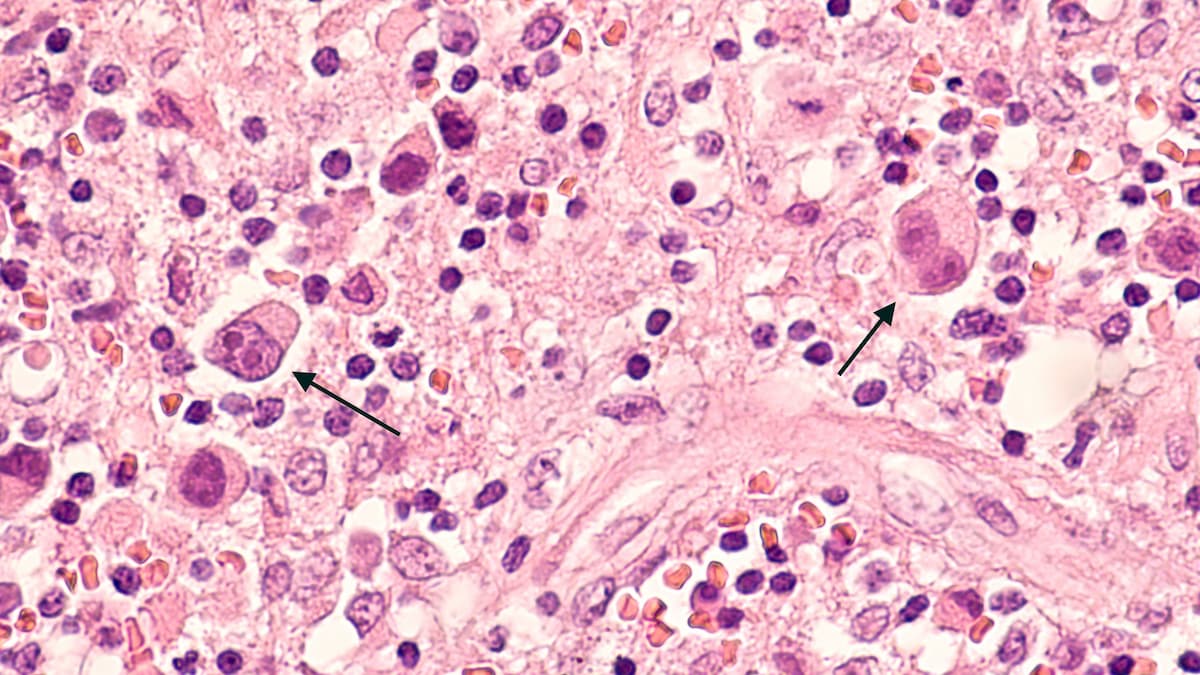A close-up of a red cell with a red blood cell in the backgroundI: © Bipul Kumar – stock.adobe.com
While advancements in T-cell lymphoma therapies have lagged behind those in B-cell lymphomas, recent years have seen progress with multiple immunotherapeutic approaches being explored. These include checkpoint inhibitors targeting PD-1/PD-L1, macrophage checkpoint inhibitors targeting CD47, monoclonal antibodies, antibody-drug conjugates, bispecific antibodies, recombinant fusion proteins, and chimeric antigen receptor (CAR) T-cell therapies. Despite promising results, unique challenges persist.1
T-cell lymphomas are rare and highly heterogeneous, making clinical trial enrollment difficult. A significant concern is that malignant T cells often share surface markers with healthy T cells, raising the risk of T-cell aplasia and opportunistic infections. CAR T-cell therapies targeting antigens such as CD5, CD7, and CD30 show potential but face issues like fratricide during manufacturing and long-term immune suppression.
FDA-approved therapies like denileukin diftitox (Lymphir)and innovative bispecific antibodies are reshaping treatment options, particularly in cutaneous T-cell lymphoma (CTCL).2 Stefan K. Barta, MD, MS, emphasized that combining immunotherapies with epigenetic or pathway-targeted agents may enhance efficacy and safety.
In an interview with Targeted Oncology, Barta, director of the T-Cell Lymphoma Program, executive officer of the AIDS Malignancy Consortium, and associate professor of clinical medicine (hematology-oncology) at Penn Medicine in Philadelphia, Pennsylvania, discussed the evolving landscape of immunotherapies for T-cell lymphomas.
Lymphoma: © David A Litman – www.stock.adobe.com

Targeted Oncology: Can you describe the different types of immunotherapies currently being investigated or used for T-cell lymphoma?
Barta: In T-cell lymphomas, we are a little behind compared with the B-cell lymphomas, but over the last decade, there have been different types of immunotherap[ies] used in T-cell lymphomas, and those can be classified into immunotherapies that target the surface antigens and immunotherapies that target more [of] the immune response. For example, through checkpoint inhibition, particularly inhibition of the T-cell checkpoints or the macrophage checkpoints—if you look at the checkpoint inhibitors, we have the T-cell checkpoint inhibitors targeting mainly PD-1 [and] PD-L1 that have some moderate activity in T-cell lymphomas. That is different depending on what subtype of T-cell lymphoma you’re dealing with. These agents are probably more effective in extranodal NK/T-cell lymphoma and in cutaneous T-cell lymphomas than they are in [peripheral T-cell lymphoma (PTCL)]. There’s always a small concern about hyperprogression that has been demonstrated with the use of these agents in smoldering [adult T-cell leukemia/lymphoma (ATLL)] and may also be occurring in other T-cell lymphoma subtypes, but is not really well characterized. But in general, they probably lend themselves very much to combinations, for example, with epigenetic therapies, and a lot of studies are ongoing there.
We have the macrophage checkpoint inhibitors, where macrophage phagocytosis is regulated by an “eat me” and a “do not eat me” signal. And the “do not eat me” signal is often regulated by expression of CD47 on the tumor cells that then inhibit the macrophage phagocytosis. We can target those signals by blocking the “do not eat me” signal and/or giving an “eat me” signal. There are several drugs that are under investigation that have also some modest activity as single agents but may again lend themselves as drugs for combinatorial regimens.
The most common approach is that we target the cell surface antigens, and we can do that with monoclonal antibodies. We have some of them approved, for example, in cutaneous T-cell lymphomas. We have a drug that targets CCR4, mogamulizumab [Poteligeo], that has led to a significant improvement for patients with mycosis fungoides and Sézary syndrome and also has activity in ATLL.
We have a very successful [antibody-drug conjugate] that targets CD30, brentuximab vedotin [Adcetris], and that, particularly when combined with chemotherapy for anaplastic large cell lymphoma and other CD30-positive lymphomas, has shown an improvement in progression-free and overall survival.
We have recombinant fusion proteins that combine a toxin with an antibody to deliver that toxin to cancer cells. And we have denileukin diftitox [Lymphir] approved for CTCL.
We have a lot of bispecific monoclonal antibodies under investigation that hopefully will also move the field. Lastly, we have cellular therapies that target the cell surface antigen, such as CAR T-cell therapy. There have been several targets that have been explored and have already published data, particularly CD30, CD5, CD7, CD70, and TCRβ1. We have seen a lot of feasibility data, meaning we have had a lot of difficulties developing these drugs for T-cell lymphoma because there’s the concern of fratricide. These cells kill each other during the manufacturing process; the CAR T cells kill the other CAR T cells because they express the same antigen. And of course, T-cell aplasia, when the CAR T cells that target the malignant cells also unfortunately target the normal T cells—because the issue is that we have expression of the same antigens on normal cells as well as on the malignant cells—that can lead to T-cell aplasia that can be associated with severe, life-threatening infections, activation of otherwise latent viruses, or even occurrence of second malignancies. And these have been obstacles, but several studies have shown it is feasible and have shown some early promising results, and a lot of investigations are ongoing at present.
What are just some of the most recent clinical trial results regarding immunotherapies in this space?
The immunotherapy field is very wide, with a lot of different approaches that have been tried. There have been several approvals based on drugs that have shown at least a progression-free survival, if not an overall survival benefit with these approaches. The drugs that stand out and have changed the playing field are mogamulizumab, currently for the treatment of Sézary syndrome and mycosis fungoides—that is a monoclonal antibody against CCR4. The other drug that stands out and has changed the playing field is brentuximab [vedotin].
And a lot of clinical trials are ongoing with bispecific monoclonal antibodies—for example, targeting CD30 and linking the CD30 monoclonal antibody, for example, to NK cells like CD16. We have seen promising clinical trial data there, especially when we use allogeneic NK cells to be reinfused during part of the treatment to enhance the activity of these bispecific antibodies.
And a lot of research is going on with CAR T cells in T-cell lymphoma, particularly CD5 and CD7, where we have some promising early clinical data.
What are some of the major challenges or limitations associated with immunotherapy in T-cell lymphoma?
The major challenge is that the T cells are often the cells effecting the anticancer effect, and they are at the same time the malignant cells. S, targeting the cancer with T cells can be much more difficult than it is in other cancers, where the effector cell is not at the same time the malignant cell, particularly with CAR T-cell therapy.
We are using T cells to target T cells, and that comes with the problem that many of these antigens are shared, leading either to killing of the effector cells of each other—leading to destruction of normal T cells that we do need. And T-cell aplasia is not compatible with long life, unfortunately. That is something that needs to be addressed.
Also, some of the mechanisms [are] at the same time suppressors in tumor growth. We take these checkpoints off, and we may thereby lead to more aggressive presentation of the cancer, as we have seen in some of the T-cell lymphomas with checkpoint inhibition, particularly in ATLL, for example. So that adds an extra layer of complications that needs to be addressed, which makes it much more challenging and explains why we’re a little behind in T-cell lymphomas as compared to B-cell lymphomas.
The other challenge is that T-cell lymphomas are very heterogeneous. We have over 26 subtypes at present, and they’re very rare. So, when you have only 10% to 15% of all lymphomas in the United States and Europe being T-cell lymphomas—they are more common in Asia, for example, where in some parts, 25% of the non-Hodgkin lymphomas are T-cell lymphomas—but still a rare disease. And you have the extra heterogeneity, so that for some diseases, you get to very small numbers, and it’s very difficult to then study an effect on these small patient subsets.
What are some of the most critical adverse events seen with these?
The main aspect is that when you kill the malignant T cells, you may also kill the normal T cells. That can lead to reactivation of latent viral infections such as [cytomegalovirus] or [Epstein-Barr virus (EBV)]. That can in turn lead to infections or things like macrophage activation syndrome or [hemophagocytic lymphohistiocytosis] or even an EBV-positive malignancy. Furthermore, other opportunistic infections are much more common. So, these need to be addressed very aggressively in terms of prophylactic therapy or monitoring for reactivation of these viruses—that is one of the major concerns.
The other concern in terms of toxicity. For example, for CAR T-cell therapy, the usual CAR T-cell toxicities are cytokine release syndrome and neurological [adverse events]. That’s specifically for CAR T-cell therapies. For other immunotherapies—each different immunotherapy may have specific side effects that we see with specific drugs, and that can vary widely from neuropathy that can be seen with some of the antibody-drug conjugates, for example, skin rashes that can be seen with some of the monoclonal antibodies, or other autoimmune phenomena, which is another issue that can be seen with immunotherapies directed against T cells.
Are there any emerging technologies or agents that you believe could significantly impact treatment?
Emerging technologies are clearly the development of cellular therapies. That comprises CAR T cells, but there are other cells that can be used—for example, NK cells or subtypes of T cells that then overcome some of the obstacles that I had mentioned, like the T-cell aplasia—because we only target very specific subsets of the T cells with certain drugs. That’s clearly an area of research. That means we have to identify which are the best targets. So, we have several targets, and as T-cell lymphomas are a very heterogeneous group of diseases, not all of these targets may be applicable to a large population. We might get into very small subtypes. As I mentioned, targeting gamma delta T cells that constitute often a very aggressive subtype of T-cell lymphoma can be difficult, as this is an extremely rare cancer. We will have to pool resources to allow that research and get input from industry and multicenter and international collaborations to get this trial off the ground.
The other areas of research are: How can we combine these immunotherapies with other agents to make them more effective or reduce toxicities? For example, epigenetic therapies hold a lot of promise in combination with some of the immunotherapies, but other pathway inhibitors may also be promising. As I said, either increasing efficacy or reducing toxicity of these therapies.
